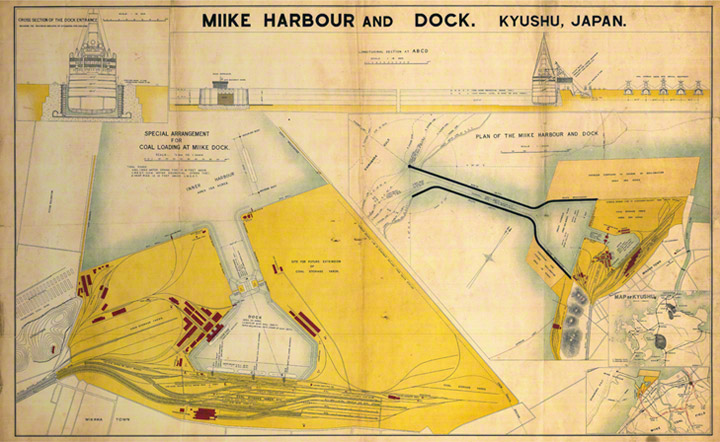When Mitsui took over the ownership of Miike, Takuma Dan, coal manager and graduate of Massachusetts Institute of Technology, made the decision to develop a modern coal port near the mine. The Ariake Sea is famous for its shallow and marshy tidal flats, with the tidal range of 5.5m. It was therefore a major challenge to build the coal port that Miike needed. The construction of the port first started with the construction of a cofferdam. Then they drained the area of shallow marshy sea. An inner basin was constructed on the dry seabed and then an area was reclaimed for coal loading. Next they built the inner harbour, with a pool, and dredged a long navigation channel to the Ariake Sea, building a pair of breakwater groins to prevent siltation and to provide deep water for larger vessels to enter the port. The lock gates were manufactured by Thames Civil Engineering Ltd., in the UK, and installed by the Miike machinery company. On either side of the lock gates, there is a set of sluice gates used to equalise the water level within the dock with that of the tidal level outside the dock, before the lock gate could be opened. The port was completed in 1908 and, in plan, resembled the shape of a hummingbird - a masterpiece of civil engineering created with the cutting edge technology of Meiji Japan. The lock gate and sluice system is still in regular use.
The humming bird port design successfully enabled large ships to moor both in large outer harbour and inner floating basin. Hydraulic lock gates maintain the water level in the inner floating basin at more than 8.5 metres allowing the mechanical coal-loading of large steamships regardless of the tide. Miike Port was electrified and equipped with a rank of fully-mechanized bulk coal loaders on the wharf. Miike Coal Mines and Port illustrates a rapid absorption and adaptation of engineering principles by Japanese engineers and their application to the successful industrialization of the country by the early twentieth century.
| Designation: | Landscaped important structure |
|---|---|
| Address: | Shinminato, Omuta city * Lock gate is not opened for public. |
| Tel: | 0944-41-2515 (Omuta City) |















 Miike Coal Mine
Miike Coal Mine Misumi West Port
Misumi West Port